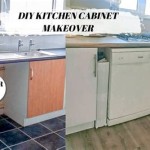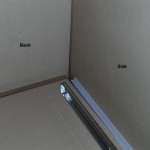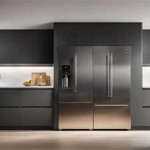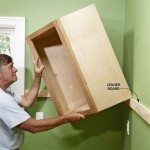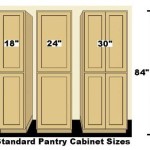Kitchen Cabinet Door Replacement: A Comprehensive Guide
Kitchens are often considered the heart of a home. The appearance and functionality of a kitchen significantly impact the overall ambiance and the homeowner's daily experience. One of the most visible and frequently used aspects of a kitchen is its cabinetry. Over time, cabinet doors can become worn, damaged, or simply outdated, leading homeowners to consider various renovation options. Replacing the entire cabinetry system can be a substantial undertaking. Therefore, replacing only the cabinet doors emerges as a cost-effective and less disruptive alternative to refresh a kitchen's aesthetic appeal and functionality.
This article will delve into the intricacies of kitchen cabinet door replacement, providing a comprehensive guide to help homeowners understand the process, benefits, considerations, and options available. It will cover aspects from assessing the existing cabinets to selecting the right replacement doors and ensuring a professional-looking installation.
Determining the Need for Replacement
The decision to replace kitchen cabinet doors should be based on a careful evaluation of several factors. These factors generally fall into the categories of aesthetic concerns, functional issues, and budgetary considerations. Recognizing these factors will enable homeowners to make informed decisions about the most suitable course of action for their kitchen renovation project.
Aesthetic Concerns: One of the primary reasons for replacing cabinet doors is to update the kitchen's appearance. Outdated styles, faded finishes, or simply a desire for a fresh, modern look can prompt a cabinet door replacement project. Styles change, and what was once trendy might now appear dated. Replacing doors can instantly transform the kitchen's style from traditional to modern, or from rustic to minimalist, without the expense of gutting the entire space.
Furthermore, visible damage such as scratches, dents, or peeling veneer can significantly detract from the kitchen's overall appeal. While minor imperfections can sometimes be repaired, extensive damage may warrant replacement for a more seamless and polished look. A unified aesthetic throughout the kitchen contributes greatly to a feeling of cleanliness and order.
Functional Issues: Beyond aesthetics, the functionality of cabinet doors plays a crucial role in the kitchen's usability. Doors that are warped, misaligned, or difficult to open and close can be a source of daily frustration. Warping can occur due to moisture exposure or age, causing the doors to no longer fit correctly within the cabinet frames. Misalignment can lead to uneven gaps and difficulty latching, while sticking doors can be a safety hazard and a nuisance.
Damaged hinges or hardware can also compromise the functionality of cabinet doors. Loose or broken hinges can cause doors to sag or swing improperly, and faulty latches can prevent doors from closing securely. Replacing the doors along with new, high-quality hardware can significantly improve the overall user experience in the kitchen.
Budgetary Considerations: A full kitchen remodel can be an expensive undertaking. Replacing only the cabinet doors provides a more budget-friendly way to update the kitchen's look without incurring the costs associated with replacing the entire cabinetry system. The cost of new cabinet doors will vary depending on the material, style, and complexity of the design, but it is generally significantly less than the cost of new cabinets.
By carefully weighing the aesthetic, functional, and budgetary factors, homeowners can determine if replacing kitchen cabinet doors is the right solution for their needs. If the existing cabinet boxes are structurally sound and only the doors are showing signs of wear or are stylistically outdated, replacement is often the most practical and cost-effective option.
Selecting the Right Replacement Doors
Once the decision to replace cabinet doors has been made, selecting the right replacement doors is a critical step. The choice of material, style, and finish will significantly impact the kitchen's overall appearance and functionality. Careful consideration should be given to each of these aspects to ensure that the new doors complement the existing cabinetry and meet the homeowner's specific needs and preferences.
Material Selection: Cabinet doors are available in a variety of materials, each with its own advantages and disadvantages. Common materials include wood, laminate, thermofoil, and metal. Wood doors offer a classic and timeless look, and they can be stained or painted to match any décor. However, wood doors are generally more expensive than other options and require more maintenance to prevent warping or damage from moisture.
Laminate doors are a more affordable alternative to wood, and they are available in a wide range of colors and patterns. Laminate is a durable and easy-to-clean material, making it a popular choice for busy kitchens. Thermofoil doors are made by wrapping a layer of vinyl over a substrate, such as MDF (Medium Density Fiberboard). Thermofoil is a cost-effective option that is resistant to moisture and easy to maintain. Metal doors offer a sleek and modern look, and they are often used in contemporary kitchen designs. Metal doors are durable and easy to clean, but they can be more expensive than other options.
Style Selection: The style of the cabinet doors should complement the overall design of the kitchen. Common cabinet door styles include raised panel, recessed panel, slab, and shaker. Raised panel doors feature a raised center panel, adding depth and dimension to the cabinets. Recessed panel doors have a flat center panel that is set back from the frame, creating a clean and simple look. Slab doors are flat and featureless, offering a minimalist aesthetic. Shaker doors are characterized by their simple, clean lines and recessed panel, making them a versatile choice that works well in a variety of kitchen styles.
The choice of door style should also consider the existing hardware and fixtures in the kitchen. If the kitchen has traditional hardware and fixtures, raised panel or recessed panel doors may be a good choice. If the kitchen has modern hardware and fixtures, slab or shaker doors may be a better fit.
Finish Selection: The finish of the cabinet doors should complement the color scheme of the kitchen and provide the desired level of durability. Common cabinet door finishes include paint, stain, and glaze. Painted doors offer a wide range of color options and can be easily updated to match changing trends. Stained doors highlight the natural beauty of the wood grain and add warmth to the kitchen. Glazed doors feature a decorative coating that adds depth and dimension to the finish.
When selecting a finish, it is important to consider the level of maintenance required. Painted doors may require more frequent touch-ups than stained doors, especially in high-traffic areas. Glazed doors can be more difficult to clean than other finishes. By carefully considering the material, style, and finish options, homeowners can select the right replacement doors to transform their kitchen into a beautiful and functional space.
The Replacement Process: A Step-by-Step Guide
The process of replacing kitchen cabinet doors involves several key steps, from measuring the existing doors to installing the new ones. Careful attention to detail and proper technique are essential for achieving a professional-looking result. The following step-by-step guide provides a comprehensive overview of the replacement process.
Step 1: Measuring the Existing Doors: Accurate measurements are crucial for ensuring that the new doors fit properly. Begin by measuring the height and width of each door, taking measurements from the back of the door to ensure accuracy. It is important to measure each door individually, as there may be slight variations in size. Note the type and location of the hinges, as this information will be needed when ordering the new doors.
If the existing doors have any special features, such as decorative panels or routed edges, make sure to note these details as well. This information will help to ensure that the new doors match the existing cabinetry as closely as possible. Double-check all measurements before placing the order to avoid costly mistakes.
Step 2: Ordering the New Doors: Once the measurements have been taken, it is time to order the new doors. When ordering, provide the exact measurements for each door, as well as the type and location of the hinges. Be sure to specify the desired material, style, and finish of the doors. It is also important to order any necessary hardware, such as new hinges and pulls, to complete the installation.
Many companies offer online ordering options, which can be convenient for homeowners who are comfortable with technology. However, it is often helpful to visit a local cabinet shop or home improvement store to see the doors in person and discuss the project with a professional. This can help to ensure that the doors meet the homeowner's expectations and are of the desired quality.
Step 3: Preparing the Cabinet Frames: Before installing the new doors, it is important to prepare the cabinet frames. Start by cleaning the frames thoroughly to remove any dirt, dust, or grease. Inspect the frames for any damage, such as cracks or loose joints. If any damage is found, repair it before proceeding with the installation.
If the existing hinges are being reused, make sure that they are in good condition. Clean the hinges and lubricate them if necessary. If the hinges are damaged or worn, replace them with new ones. It is also a good idea to check the alignment of the cabinet frames to ensure that the doors will hang properly. If the frames are misaligned, adjust them as needed.
Step 4: Installing the New Doors: With the cabinet frames prepared, it is time to install the new doors. Start by attaching the hinges to the new doors, making sure that they are aligned properly. Then, carefully align the doors with the cabinet frames and attach the hinges to the frames. Ensure that the doors swing freely and close properly. Adjust the hinges as needed to achieve a perfect fit.
Once the doors are installed, attach any hardware, such as pulls or knobs. Make sure that the hardware is securely fastened and that it is aligned properly. Finally, inspect the doors for any imperfections. If any imperfections are found, touch them up with paint or stain as needed.
By following these steps carefully, homeowners can successfully replace their kitchen cabinet doors and transform the look of their kitchen. While this project can often be a DIY endeavor, it’s also advisable to seek professional consultation during decision-making stages, or even hire a professional installation service if the homeowner lacks the skills and tools to do the job correctly.

Best Kitchen Cabinet Refacing For Your Home The Depot

Cabinet Doors Drawers Replacement Revelare Kitchens

Fast Cabinet Doors Custom Replacement For Kitchen Cabinets Cupboards

How To Add Glass Cabinet Doors Confessions Of A Serial Do It Yourselfer

Kitchen Cabinet Doors At Com

Best Kitchen Cabinet Refacing For Your Home The Depot

How Much Does It Cost To Replace Kitchen Cabinet Doors

Reface Or Replace Your Kitchen Units Dream Doors

Replace Dated Oak Kitchen Doors To Gray Shaker

Kitchen Door Replacement Replace Cabinet Doors Only
Related Posts


